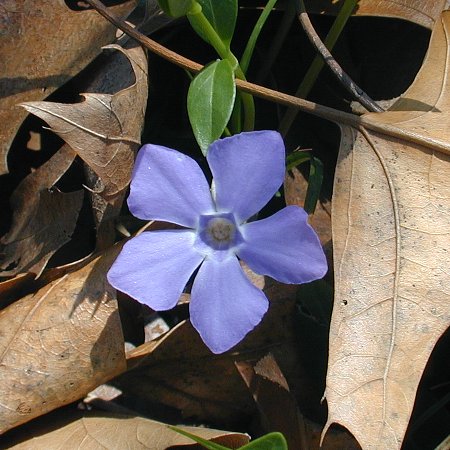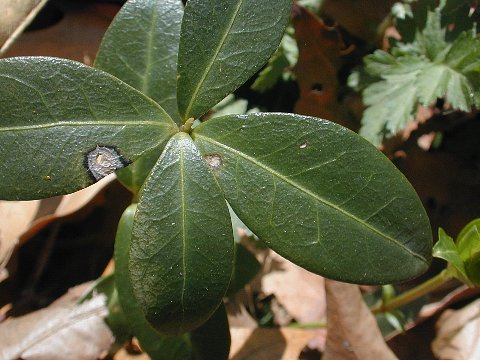Description: This perennial plant has a vine-like habit, producing stems up to 3' long that sprawl across the ground. The slender stems are hairless and become somewhat woody with age. The opposite leaves are up to 1¼" long and ½" across and evergreen, rather than deciduous. They are hairless, ovate, blunt-tipped, and smooth along the margins. Their upper surface is dark green and shiny, and their texture is rather leathery. The slender petioles are shorter than the blades of the leaves. From the axils of the upper leaves, there occasionally develops individual flowers on slender stalks up to 6" long. There is only a single stalk (peduncle) per leaf axil, which is slender, hairless, and leafless. Each flower is about ¾–1" across, consisting of a corolla with 5 spreading lobes that are truncate or slightly notched along their outer margins. The length of the lobes on each side is slightly asymmetrical, providing the flowers with a pin-wheel appearance. The color of the corolla is lavender or light blue-violet. The throat of the flower has the shape of a 5-angled star that is white along the edges. The tubular green calyx has 5 slender teeth. It is hairless and much smaller than the corolla. The blooming period usually occurs during late spring and lasts about a month. The flowers are sparingly produced. From each flower that is fertilized, there can develop a pair of follicles (seedpods that split open along one side) that are long and slender. However, follicles rarely develop from flowers in Illinois. When they occur, each follicle contains several tiny black seeds that can be blown about in the wind. These seeds are without tufts of hair. The root system produces woody rhizomes and slender secondary roots. This plant can reproduce vegetatively through underground runners, or the stems above ground can form rootlets at the leaf nodes. It often forms dense colonies that exclude other species of plants.

Cultivation:
The
preference is partial sun or light shade and moist to slightly dry
conditions. Various kinds of soil are tolerated, including loam with
abundant organic material, clay-loam, and rocky soil. This plant is
rather aggressive, and can regenerate itself from small pieces of the
roots remaining in the ground.
Range & Habitat:
Lesser Periwinkle occurs occasionally in the wild throughout Illinois,
except in the NW counties, where it is uncommon or absent (see Distribution
Map). It was introduced into the United States from
the Mediterranean area of Europe as a horticultural plant. Habitats
include deciduous woodlands, woodland borders, rocky bluffs or banks,
cemeteries, sites of abandoned homesteads, city parks where woody
vegetation occurs, and semi-shaded areas along roads. Lesser Periwinkle
is commonly planted as a ground cover around shrubbery and along the
foundations of buildings in both residential and commercial areas. This
plant can smother the native spring wildflowers in deciduous woodlands,
covering large areas of the ground. Fortunately, it rarely produces
seed and therefore doesn't spread across long distances to the same
extent as some other invasive plants.

Faunal
Associations:
According to Müller of 19th century Germany, the nectar of the flowers
attract bumblebees, Anthophorine bees (Anthophora spp.),
mason bees (Osmia spp.), and bee flies
(including Bombylius
major). In Illinois, such insect visitors appear to be
few. The seeds are too small to be of any interest to birds, and the
foliage is toxic to mammalian herbivores. This plant appears to have
little ecological value to fauna.
Photographic Location:
The edge of a wooded area at Crystal Lake Park in Urbana, Illinois.
Comments:
Both the flowers and foliage have an attractive appearance that is
somewhat melancholy. Therefore, it is not surprising to find Lesser
Periwinkle in use as a ground cover, particularly around cemeteries.
This plant has a distinctive appearance that can't be confused with any
other plant species, except for the closely related Vinca
major (Greater Periwinkle). This latter species naturalizes
less often and is uncommon in Illinois. It differs from Lesser
Periwinkle by its larger flowers (about 1–1½" across) and the ciliate
hairs of its calyx. The calyx of Lesser Periwinkle, as indicated above,
is hairless. Other common names for this species is Common Periwinkle
and Running Myrtle.